More and more children and adults are entering our examination rooms with a spectrum of disorders—ranging from learning disabilities (LD) to autism. If you think about the spectrum of disabilities, LD is at the milder end, attention deficit disorder (ADD) and attention deficit hyperactivity disorder (ADHD) are in the middle and Asperger’s and autism are at the more severe end. It is helpful to think in these terms because while there may be no cure for some of these disorders, there are many treatment modalities; and those treatments affect the outcomes and eventual diagnoses.1 In this article, let’s explore the unique considerations you must make in the effective management of patients on the spectrum to improve their vision, thereby elevating their quality of life.
Potential Predisposing Factors
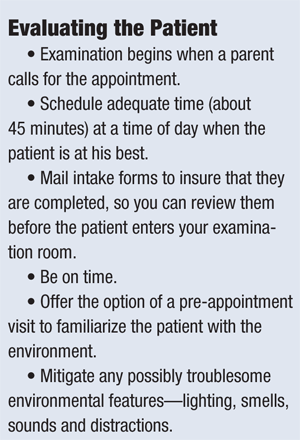
Although there is no consensus in the medical community on the exact cause of autism, theories about genetic predisposition and the impact of various environmental and lifestyle factors, as well as vaccines, exist.
• Vaccines. There is much controversy as to the etiology of autism. The vaccine debate is raging with most medical professionals stating that there is no evidence that vaccines cause autism. Some, however, insist there is an abundance of evidence indicating that toxins in the environment contribute to the increased numbers on the spectrum, with vaccination being one of the sources of harmful substances to which children are exposed in increasing amounts. The culprit in vaccines was thought to be the preservative thimerosal, a mercury derivative. On July 7, 1999, the Centers for Disease Control (CDC) and the American Academy of Pediatrics (AAP) released a statement requesting that pharmaceutical companies remove thimerosal from all childhood vaccines. However, the influenza vaccine, which most pregnant women and infants are urged to receive, still contains thimerosal and many vaccines contain other harmful chemicals such as aluminum and formaldehyde. While the amount of thimerosal in each vaccine is minimal, it has been proposed that autism may be a result of the cumulative effect of the thimerosal as well as other harmful chemicals in vaccines administered before six months of age.2-4
• Toxins. While efficacy is sound for the vaccinations, children are still exposed to other toxic substances—albeit in small, supposedly safe amounts. The Food and Drug Administration (FDA) recently released a warning about certain toothpastes that contained the active ingredient in antifreeze, diethylene glycol. Some of the other sources of toxins in the environment can be found in the food and water we consume. Mercury, polychlorinated biphenyls (PCBs), as well as traces of pharmaceutical waste products are dumped into our waste system and, as a result, are present in our water sources. Combine the toxic environment with other environmental stressors on the body, and developmental delays are likely to increase.5,6
• Sedentary Lifestyle. Such societal changes as less activity, less outdoor play and less free play may also be contributing factors. Children are more restricted by car restraints, play in saucers and experience less tummy time due to the risk of Sudden Infant Death Syndrome (SIDS). As a result, children do not have the opportunity to properly develop their muscles and explore their environment. There is also some evidence that insufficient outdoor play and the subsequent decrease in exposure to sunlight and Vitamin D affects development.7
• Diet. The foods that children consume have drastically changed in the last 60 years, resulting in yet another stress to the immune system. Many of the commercially produced foods contain wheat, soy, corn and dairy products that tend to irritate the digestive system. These foods are often genetically modified, and the animals that we ingest are fed hormones and antibiotics that may have an influence on the humans that consume them. Part of the problem with antibiotics is that many children are over-exposed to them due to frequent ear infections. Antibiotics destroy the good bacteria in the lining of the gut that aids in digestion. Poor digestion results in poor absorption of nutrients and decreased nutrition for the developing brain.
Knowledge of the many factors contributing to the declining health and increased delays in child development aids in making appropriate referrals for treatment and understanding the importance of looking at the whole person and not just one system.6
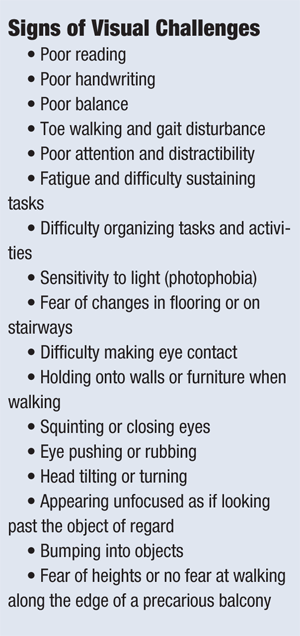
Combating the Causes
As primary care providers we are in a position to educate our patients and their parents on practices that aid in development and optimize vision.
• Diet. Changing the diet can potentially make a big difference in terms of behavior, development and ultimately, function. As primary eye care providers, there are some minimal recommendations that we can make. Eliminating white foods such as dairy, wheat, soy, salt and sugars and substituting them with a rotating diet of varied foods such as whole grains, fruits, vegetables and protein sources is helpful.6 Buying organic produce and meat is important, and if dairy is tolerated, organic milk, butter and eggs are preferred. Simple, good quality meals without artificial colors, flavors and additives are also recommended as well as hydration with clean water.6, 8-11
• Supplementation. Nutritional support may also be required. Minimal supplementation can include essential fatty acids, calcium, magnesium, zinc, vitamins A, C and E, B6, B12, selenium and probiotics. The omega-3 fat docosahexaenoic acid (DHA) enhances visual development in infants and young children.14 Elementary school-aged children demonstrate improvements in reading, spelling and behavior while taking DHA. Zinc, a cofactor for vitamin A, is important as it is present in high concentrations in the retina and choroid. Deficiencies in zinc and vitamin A may contribute to poor eye contact. Vitamins A and B supplementation can improve overall visual functioning.12-15
• Exercise. Getting adequate exercise—preferably outdoors to ensure proper vitamin D levels—should be encouraged. For the younger children, tummy time, crawling before walking and plenty of time for free play is necessary for development.
The Vision Exam
When it comes to patients on the spectrum, your examination begins with the initial phone call. A well-trained staff person is important in determining the patient’s primary difficulties and any special considerations necessary for examining the child. Such concerns include sensitivities to loud noises, crowds in the waiting room and avoiding scheduling during nap and meal times. A phone intake form can be a helpful source of pertinent patient information, basic difficulties and the referral source. Once the appointment is made, it is helpful to mail information about the practice, if available, and a history form prior to the appointment (see “Evaluating the Patient”).
Careful Observation
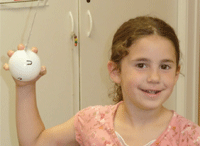
Marsden Ball on string helps patients improve their visual motor skills.
Upon arrival, make every effort to be on time. Then, observe how the child responds, makes eye contact and even walks to the examination room. All of this offers information about the individual’s level of functioning and ability.
Classically, these individuals have limited eye contact, poor social skills and differences in language ability—ranging from little to no verbal ability at all, echoing your speech to highly evolved, almost excessive talk about specific topics. Their speech may be lilting, monotone and/or repetitive. They may have limited receptive language or difficulty understanding what is being asked of them. Simple commands with limited pronouns and connecting words may be helpful such as, “Say letter,” instead of “What letter do you see?” These individuals may also be very concrete thinkers and have difficulty with more abstract concepts such as, “Read the lowest line you can see.” Single letter or picture presentations work best.
Another hallmark of ASD patients is sensory integration difficulties. In other words, they have difficulty relating to their environment in terms of proprioception and movement. They often are extremely sensitive to touch, noise and texture. Tags on clothing, edges on the chair and changes in flooring can all disturb them.
Fluorescent light flicker may bother them and the garbage truck’s wheels squeaking down the street may distract them. Some of the behaviors they exhibit are a response or reaction to stimuli in their environment and an attempt to relate to the world. For example, they may exhibit blinking, squinting, reddened eyes, closing an eye, moving closer to view objects, lack of focus and poor eye contact. Other, less obvious signs of visual problems include poor reading, poor handwriting, poor balance, toe walking and gait disturbances, poor attention and distractibility, fatigue and difficulty sustaining attention to tasks, and difficulty organizing tasks. In addition, they may exhibit such visually stimulating behaviors as hand flapping, quick side glances and staring at certain objects or patterns. (see, “Signs of Visual Problems” page 86 and “Visually Stimulatory Behaviors” page 88)
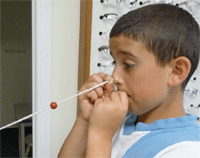
Brock string convergence therapy with ready-made lenses and prisms.
A Special Approach
Once in the examination room, there are a few considerations to remember. First, be flexible. The examination sequence may have to be varied, and you may be required to be creative in presentation of tests. Because language may be a barrier to obtaining acuity measures, Lea gratings, AO picture charts and Lighthouse cards may be used. It is helpful to ask the parent what the child’s ability is, as they may be able to identify letters at a very early age.
Familiarizing the patient with picture charts and cards at near is also recommended. They may also be able to identify pictures and/or letters at distance by pointing to the corresponding picture or letter at near if language is an issue. Isolating just a few items to match at near is often necessary.
• Refraction. Refractive status is best measured using the retinoscope as opposed to autorefraction. However, you will not typically find high refractive errors in this population. Skiascopic lens racks and even loose lenses or varied flipper lenses are helpful tools with these patients. Assessment of refraction is best reserved after any oculomotor and binocular tests due to potential photophobia. Patients on the spectrum often respond favorably to low plus lenses, so near retinoscopy is recommended and observation of the reflex with low plus lenses should be made. You are looking for a brighter reflex and more engagement with the target and thus, improved accommodative response.15,16
• Oculomotor Testing. Oculomotor testing of fixation, pursuit and saccades should be evaluated, as typically individuals on the spectrum are challenged in these areas. In particular, fixation is limited, which results in reduced eye contact—negatively impacting the ability to learn in the classroom and to engage in social activity. High interest targets are often required for testing basic eye movement skills.
• Binocularity. The importance of binocular testing cannot be stressed enough. Poor binocularity—including reduced stereopsis—is often found in these individuals.
The result is poor visual attention, as well as safety concerns. At minimum, a cover test, near point of convergence and stereoscopic responses should be evaluated.
Basic vergence ranges can be taken using a prism bar as phorometric testing may be impossible. Often convergence is a challenge for individuals on the spectrum, particularly if they report side looking, closing an eye or turning the head to the side. They may also exhibit a higher incidence of strabismus than the typical population.15,16
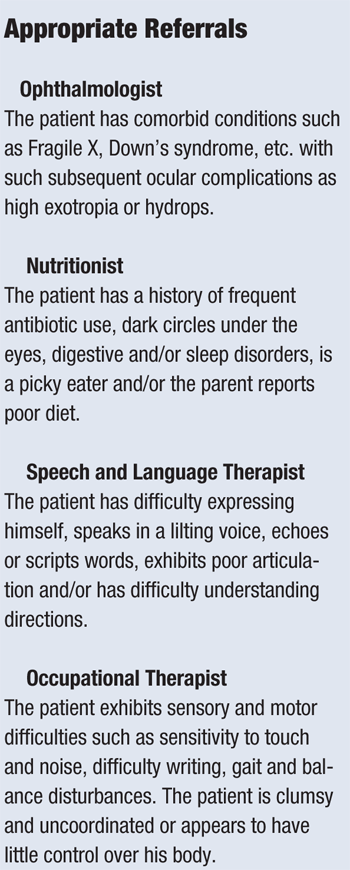
• Performance Testing. It is important to see how your examination findings translate into patients’ ability to function in their daily activities. Observe how the patient can catch a ball, insert pegs into a pegboard, construct puzzles, and draw or color. While the patient is performing these activities, observe everything including posture, balance, choice of toys, use of senses, laterality, interactions with the environment and those in it, motor skills, language, cognition and awareness. Your notes will contain the most useful information you will obtain from the examination because the child is engaged. Left alone to explore the environment, the child invites us to learn how they function in a real scenario. This is a great time to observe how lenses affect the child’s behavior. The child may totally miss the ball in a ball catch game and just stare at the ceiling. With lens and prism glasses, the child then looks and catches the ball directly.
• Ocular Health. An assessment of ocular health is best reserved for the end of the examination because patients may be extremely sensitive to light, and their sensory system may be overwhelmed by a stranger and/or instruments getting so close to them. Often, direct ophthalmoscopy is all that is possible but every attempt at ensuring ocular health internally and externally should be made. If a dilated fundus examination is warranted, it is often helpful to have patients return to the office, so they do not initially associate the office with the discomfort of dilating drops.
Treatment Modalities
• Lens and Prism Prescribing. Children on the spectrum may not need corrective lenses but respond favorably to low amounts of plus and/or prisms. The low plus lenses are often helpful in patients demonstrating lags on near retinoscopy or reduced amplitudes of accommodation. Plus lenses typically in the range of +0.25D to +0.75D can be used alone or incorporated with low amounts of prism ranging from 0.5 to 3.00 prism diopters. Those demonstrating reduced near point of convergence and low base out ranges respond well to base in and/or base up lenses. Individuals with convergence excess, highly central fixation and gait disturbances (e.g., toe walking) respond best to base down prism. Yoked prism base left and right may also be helpful for those experiencing side looking and/or poor visual awareness. Ready-made prescriptions in combinations of low powered lenses and prisms are helpful to use in assessment.17,18
• Vision Therapy. Vision therapy is a highly effective treatment option for patients on the spectrum. It offers the opportunity to gain visual skills that affect overall development. Because vision is connected to so many other systems, improvements in vision often result in improvements in motor and speech and language development. The therapy is effective in treating visual disorders such as convergence insufficiency, accommodative and oculomotor dysfunctions affecting reading. Patients can make gains in visual motor ability and overall visual processing.18-21
When in Doubt, Refer Them Out
As a primary eye care provider, it is our responsibility to evaluate and treat visual concerns. Additionally, looking at possible causes of visual problems, such as nutrition, diet, toxicity, birth trauma or environment can be helpful in addressing underlying factors. Knowledge of the latest treatment options and the appropriate professional referrals is important. Your referral network of professionals who can collaborate in treatment should not only include ophthalmologists to treat any comorbid conditions but also nutritionists, developmental pediatricians, occupational and speech and language therapists, behavioral therapists and alternative medical practitioners. Additionally, behavioral optometrists should be considered if vision therapy is not offered in the office.22
As optometrists we know the importance of proper visual function in appropriate development and the ability to learn new information. If we strive to understand our patients and use our extensive arsenal of various tools and approaches, we can break down the visual barriers that patients on the autism spectrum face daily and help them lead functional and fulfilled lives.
Drs. Randy Schulman and Juanita Collier practice in Trumbull and Norwalk, Conn. They specialize in vision therapy, pediatrics, vision-related learning disabilities and preventative and alternative care for all ages.
1. Lemer P. Treatments for those on the Autistic Spectrum. JBO 1998:9(2);38-46.
2. Kirby D. Evidence of Harm, Mercury in Vaccines and the Autism Epidemic. St. Martins Press, 2005.
3. An Assessment of Thimerosal Use in Childhood Vaccines. Pediatrics. 2001 May;107(5):1147-54.
4. FDA. Common Ingredients in U.S. Licensed Vaccines. Available at:
www.fda.gov/BiologicsBloodVaccines/SafetyAvailability/VaccineSafety/ucm187810.htm. (Accessed February 2011).
5. Dorfman K. Why so many children have developmental problems: the total load theory. New Dev. 1996 Winter;1:4.
6. Lemer P. Envisioning a Bright Future: Interventions that Work for Children and Adults with Autism Spectrum Disorders. Optometric Extension Program, 2008.
7. Vitamin D Theory of Autism. Available at:
www.vitamindcouncil.org/health/autism/vit-D-theory-autism.shtml. (Accessed February 2011).
8. Reichelt KL, Ekrem J, Scott H. Gluten, milk proteins and autism. Dietary intervention effects on behavior and peptide secretion. J Applied Nutrition. 1990;42(1):1-11.
9. Knivsber AM, Reichelt KL, Nødland M. Reports on dietary intervention in autistic disorders. Nutr Neurosci. 2001;4(1):25-37.
10. Shattock W. How dietary intervention could ameliorate the symptoms of autism. Available at:
www.espa-research.org.uk/linked/publications.pdf. (Accessed February 2011).
11. Rapp D. Is This Your Child? New York, NY: Morrow, 1991.
12. Auestad N, Scott DT, Janowsky JS, et al. Visual, cognitive and language assessments at 39 months: a follow-up study of children fed formulas containing long-chain polyunsaturated
fatty acids to one year of age. Pediatrics. 2003 Sep;112(3 Pt 1):e177-83.
13. Richardon AJ, Montgomery P. The Oxford-Durham study: a randomized, controlled trial of dietary supplementation with fatty acids in children with developmental coordination disorder. Pediatrics. 2005 May;115(5):1360-6.
14. Megson M. The Biological Basis of Perceptual Deficits in Autism. Available at:
www.megson.com. (Accessed February 2011).
15. Scharre J, Creedon M. Assessment of visual function in autistic children. Optom Vis Sci. 1992 Jun;69(6):433-9.
16. Schulman R. Optometry’s Role in the Treatment of Autism. J Optom Vis Dev. 1994;25:259-68.
17. Birnbaum MH. Optometric Management of Near Point Visual Disorders. Stoneham: Butterworth-Heinemann; 1993.
18. Kaplan M. Seeing through new eyes: Changing the lives of chidren with autism, Asperger syndrome and other developmental disabilities through vision therapy. Philadelphia, PA. Jessica Kingsley Publishers, 2006.
19. Rose M, Torgerson N. A behavioral approach to vision and autism. J Optom Vis Dev. 1994;25:269-75.
20. Convergence Insufficiency Treatment Trial Study Group: Randomized clinical trial of treatments for symptomatic convergence insufficiency in children. Arch Ophthamol. 2008;126:1336-49.
21. Harris P. Learning-related visual problems in Baltimore City: A Long-Term. Program. J Optom Vis Dev. 33 (2):75-115, 2002
22. Taub M, Russell R. Autism Spectrum Disorders: A Primer for the Optometrist. Rev Optom. 2007 May:148(5);82-91.

